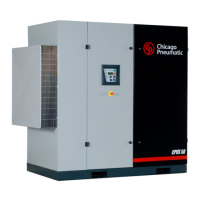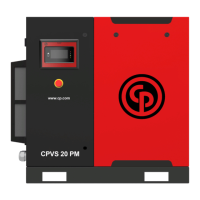Do you have a question about the Chicago Pneumatic CPVS 60 and is the answer not in the manual?
Provides general information about the CP model air compressor and its components.
Outlines guidelines for disposing of machine components and handling environmental concerns.
Lists the operating components and safety devices included in the standard version of the unit.
Explains the meaning of various pictograms used throughout the manual for safety and identification.
Refers to specific instructions for the electronic plate and its operating functions.
Details safe handling procedures for lifting and moving the CPVS compressor unit.
Specifies environmental requirements for the installation room, including ventilation and temperature.
Describes the assembly process, noting that the unit can be placed on a stable, flat surface.
Covers requirements for the air discharge pipe, including minimum diameter and valve installation.
Explains the connection of condensate drain pipes from the final cooler outlet to a manifold.
Outlines guidelines for electric cabling, including voltage, cable size, and safety regulations.
Lists checks to be performed before the initial start-up, like grounding and oil level.
Guides the user through the initial start-up procedure, including voltage and rotation checks.
Details factory settings for maximum pressure and how to adjust backflow pressure.
Discusses considerations for operating the CPVS in parallel with other compressors.
Provides safety information regarding the use of combustible liquids and appropriate fire extinguishers.
Explains the flow of air and oil through the compressor system components.
Describes a valve that prevents air consumption when the compressor is not running.
Details an option for high-efficiency air filtration to improve air quality and protect components.
Explains the function of pre-filtration panels in protecting internal components and reducing contamination.
Covers a system enabling automatic compressor restart after a power outage.
Describes the option to start and stop the compressor remotely.
Explains a system that controls rotation direction and checks power supply phases.
Details a device that bleeds condensates formed in the air cooler.
Highlights standard equipment like frequency adjusting device and fuse holder.
Lists crucial safety rules and warnings for electrical installations and handling the inverter.
Provides guidance on installing the CPVS away from transformers and defines fuse protection.
Details recommended oil, first change interval, and procedures for checking and changing oil.
Explains the type of air filter, recommended change intervals, and the importance of replacement.
Advises on fan replacement if blades are deformed or broken, and checking rotation direction.
Emphasizes care for the cooler, keeping it clean, and leak detection procedures.
Discusses factors affecting lifespan and procedures for changing the oil separator.
Outlines steps for checking and reassembling the anti-oil return pipe.
Explains the importance of draining condensation water from the oil circuit.
Refers to instructions for temperature safety tests and sensor replacement.
Stresses the need to refasten electric power cables to prevent overheating and destruction.
Provides step-by-step instructions for safely decommissioning the compressor.
Lists common operating incidents, their possible causes, and suggested solutions for troubleshooting.
Provides general information about the CP model air compressor and its components.
Outlines guidelines for disposing of machine components and handling environmental concerns.
Lists the operating components and safety devices included in the standard version of the unit.
Explains the meaning of various pictograms used throughout the manual for safety and identification.
Refers to specific instructions for the electronic plate and its operating functions.
Details safe handling procedures for lifting and moving the CPVS compressor unit.
Specifies environmental requirements for the installation room, including ventilation and temperature.
Describes the assembly process, noting that the unit can be placed on a stable, flat surface.
Covers requirements for the air discharge pipe, including minimum diameter and valve installation.
Explains the connection of condensate drain pipes from the final cooler outlet to a manifold.
Outlines guidelines for electric cabling, including voltage, cable size, and safety regulations.
Lists checks to be performed before the initial start-up, like grounding and oil level.
Guides the user through the initial start-up procedure, including voltage and rotation checks.
Details factory settings for maximum pressure and how to adjust backflow pressure.
Discusses considerations for operating the CPVS in parallel with other compressors.
Provides safety information regarding the use of combustible liquids and appropriate fire extinguishers.
Explains the flow of air and oil through the compressor system components.
Describes a valve that prevents air consumption when the compressor is not running.
Details an option for high-efficiency air filtration to improve air quality and protect components.
Explains the function of pre-filtration panels in protecting internal components and reducing contamination.
Covers a system enabling automatic compressor restart after a power outage.
Describes the option to start and stop the compressor remotely.
Explains a system that controls rotation direction and checks power supply phases.
Details a device that bleeds condensates formed in the air cooler.
Highlights standard equipment like frequency adjusting device and fuse holder.
Lists crucial safety rules and warnings for electrical installations and handling the inverter.
Provides guidance on installing the CPVS away from transformers and defines fuse protection.
Details recommended oil, first change interval, and procedures for checking and changing oil.
Explains the type of air filter, recommended change intervals, and the importance of replacement.
Advises on fan replacement if blades are deformed or broken, and checking rotation direction.
Emphasizes care for the cooler, keeping it clean, and leak detection procedures.
Discusses factors affecting lifespan and procedures for changing the oil separator.
Outlines steps for checking and reassembling the anti-oil return pipe.
Explains the importance of draining condensation water from the oil circuit.
Refers to instructions for temperature safety tests and sensor replacement.
Stresses the need to refasten electric power cables to prevent overheating and destruction.
Provides step-by-step instructions for safely decommissioning the compressor.
Lists common operating incidents, their possible causes, and suggested solutions for troubleshooting.
| Brand | Chicago Pneumatic |
|---|---|
| Model | CPVS 60 |
| Category | Air Compressor |
| Language | English |











